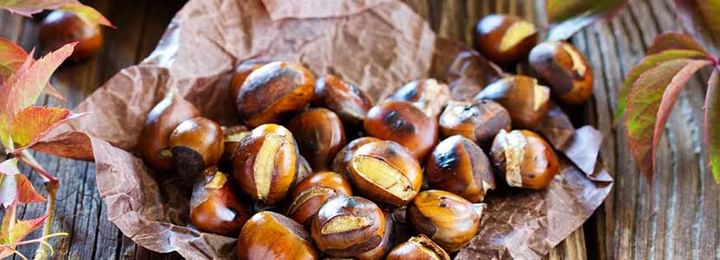Benefits of Chestnuts And Its Side Effects
Last Updated: Jan 20, 2025
Chestnuts are an extremely popular and easy to find nut. They are versatile when it comes to their usage and adding just a handful to your diet on a daily basis can help you with a host of ailments. Chestnuts are known for preventing diabetes, boosting the immune system as a whole, increasing the bone mineral density, relieving digestive problems, improving cognitive function, preventing chronic illnesses, controlling the blood pressure, improving cardiovascular health and increasing the production of red blood cells in the blood stream. All of thesehealth benefits make them a great addition to the daily diet.
Chestnuts
Chestnuts are produced by shrubs and trees that belong to the Castanea genus. They grow with a thick and hard outer shell that is brown and have a white edible kernel in the center. This kernel can be eaten raw as well as cooked.
There are many different types of chestnuts and they all have similar properties and nutritionals values. However, they should not be confused with horse chestnuts. The four main types of chestnuts consumed are the Japanese chestnut, American chestnut, Chinese chestnut and European chestnut. Chestnuts contain high amounts of dietary fibers, vitamins, minerals, good fats, and antioxidant compounds and can be used to create a balanced, healthy diet.
Nutritional Value of Chestnuts
In a 100g, chestnuts have 131 calories. The total fat present in them is 1.4g out of which there is 0.3g of saturated fat, 0.5g of polyunsaturated fats (PUSA), and 05g of monounsaturated fats (MUSA). It has 0mg of cholesterol. It contains 27mg of sodium and 715mg of potassium. The total carbohydrate content of 100g of chestnuts is 28g. It also has a total of 2g of proteins, and 4% of the recommended daily intake of calcium, 44% of vitamin C, 9% of iron, 10% of vitamin B-6, and 13% of magnesium. It has 0% of vitamin A, B-12, and D.
Nutritional facts Per 100 Grams
Vitamins and Minerals
Health Benefits of Chestnuts
Prevents diabetes
One of the least known facts about diabetes is that it can be successfully prevented with the help of dietary fibers. They can also regulate and manage diabetes in patients. Food products that have a lot of dietary fiber are considered low glycemic foods because they make the sugar levels in the blood rise more slowly. This is a benefit that is extremely important to diabetics as their treatments are all about controlling their sugar. Moreover, they prevent random drops in the sugar levels as well. This is important for people who may have a disposition towards diabetes as well as chestnuts can help preventing the disease from developing in the first place.
Boosts the immune system
Increases the bone mineral density
As the body ages, many systems are affected. One of these is the skeletal structure and a common problem amongst ageing people is osteoporosis, which occurs due to the loss of bone mass and manifests itself in the form of weakened bones and aching joints. One of the ways to prevent this is to include chestnut in your diet. Chestnuts contain magnesium which plays a big role in increasing the bone mineral density, thereby keeping the bones healthy. Chestnuts also have large amounts of copper, which plays a huge role in the way the body absorbs iron, thus contributing to overall bone health and strength.
Relieves digestive problems
Dietary fiber is the best thing to put into your body if you suffer from digestive issues. Fibers add a lot of bulk to the digested food, which helps it move down the digestive track much faster. It helps with peristalsis, the contracting and releasing of intestinal muscles to move food along, which also helps with better bowel movements. Dietary fiber also plays a role in improving the way the body absorbs nutrients, which is better on the whole. Dietary fiber can also help reduce diarrhea.
Improves cognitive function
Chestnuts have a direct impact on the brain and cognitive function. As they contain high amounts of different types of vitamin B, such as folate, thiamine, riboflavin), they can help with better focus and stronger memory. These vitamins are linked with brain development and its function and chestnuts are, therefore, a great addition to the diet of your child.
Furthermore, chestnuts also contain potassium. Potassium is known for increasing the flow of blood to the brain, keeping it well oxygenated and revitalized, and also as a positive impact on the overall health of the nervous system. This also contributes to better memory, concentration, and retention.
Prevents chronic illnesses
No matter how careful you think you are, your body is always filled with free radicals. This is not because of something you are doing or not doing. It is simply so because free radicals happen to be a byproduct of cellular respiration. They are considered slightly dangerous as they can make your healthy cells mutate and cause cancer. They can also cause a number of chronic illnesses and oxidative stress. The antioxidants in chestnuts help eliminate these free radicals, saving you from a host of problems.
Controls blood pressure
As discussed earlier, chestnuts contain potassium and this is one of the most important minerals when it comes to lowering blood pressure. Potassium acts as a vasodilator, which helps in increasing the general blood flow, therefore decreasing the overall pressure. Potassium also controls the movement of water in the body.
Improves cardiovascular health
Chestnuts are also known for improving cardiovascular health. The body requires good fats in order to balance the cholesterol and chestnuts is filled with them. They reduce any inflammation in the body which reduces any risk of strokes, heart attacks, blood clots, arthrosclerosis and coronary disease. People with a history of heart disease in the family can benefit by eating a handful of these delicious nuts every day.
Increases red blood cells
Red blood cells, also known as RBCs, are an extremely important type of cell in the blood as they carry oxygen from the lungs to different parts of the body. Chestnuts contain copper which facilitates the metabolism of iron into the blood stream and the creation of red blood cells. Without an optimal number of RBCs, the organs start to deteriorate due to the lack of fresh oxygen. Moreover, copper is an important nutrient for the body as without it, one can be at risk for anemia, osteoporosis, and irregular heartbeat.
Prevents scurvy
Scurvy is a disease that occurs when there is a deficiency of vitamin C in the body and can manifest itself in a range of symptoms such as fatigue, sore arms and legs, gum disease, and more extreme symptoms as the disease progresses such as insufficient wound healing, changes in the personality and even death if not treated. The best way to prevent scurvy is to ensure that your diet has sufficient amounts of vitamin C in it. Chestnuts are highly rich in Vitamin C and can therefore help prevent scurvy from developing.
Uses of Chestnuts
One of the most common ways to consume chestnuts is to roast them at an open fire. The outer layer cracks open easily, leaving the fleshy white inside to be consumed. However, chestnuts can be eaten in a variety of different ways.
They can be candied for delicious treats, pureed for an addition to a savory meal, and boiled and eaten just like that. They can also be ground into flour and used to make textured bread. Chestnuts can also be steamed, grilled or deep fried.
In many cuisines, chestnuts are crushed and sprinkled over meats or salads to add an extra dimension of flavor and texture to the meal.
Side-Effects & Allergies of Chestnuts
As is the case with most nuts, chestnuts are a known allergen. People who are susceptible to allergies, or have nut allergies should definitely consult with their doctor before they add these nuts to their daily diet. These allergies can range from mild to severe with eczema, rashes, itchiness and even breathing difficulties as symptoms. Some people can also get contact dermatitis, which is the developing of itching and rashes on the skin right after touching the nuts. So even though these nuts have a high nutritional value, one should be fairly careful before including them in one’s diet.
Cultivation of Chestnuts
Chestnuts originated in Asia Minor, though they are grown and found almost all over the world now. It is believed that the ancient Greeks were responsible for introducing chestnuts to the Mediterranean region 3,000 years ago.
References
- Antonio AL, Carocho M, Bento A, Quintana B, Botelho ML, Ferreira IC. Effects of gamma radiation on the biological, physico-chemical, nutritional and antioxidant parameters of chestnuts–A review. Food and Chemical Toxicology. 2012 Sep 1;50(9):3234-42. [Cited 24 June 2019]. Available from:
- Petticrew M. Systematic reviews in public health: old chestnuts and new challenges [Internet]. [Cited 24 June 2019]. Available from:
- Rutter PA, Miller G, Payne JA. Chestnuts (Castanea). Genetic Resources of Temperate Fruit and Nut Crops 290. 1991 May 1:761-90. [Cited 24 June 2019]. Available from:
Table of content
Ask a free question
Get FREE multiple opinions from Doctors



